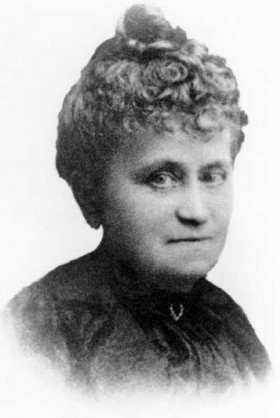Sarah H. Sampson (1832-1907) was an energetic woman who used her social and political connections to support her special public projects. This redoubtable lady came to Washington, D.C. to be near her husband, Lieutenant Colonel Charles A. W. Sampson of the 3rd Maine Volunteer Infantry at the time of the Civil War.
She occupied her time first by visiting wounded Maine boys in Washington hospitals, but soon was venturing far afield, bringing supplies, food and medicines to troops on the James River. She was often in some danger. On one occasion, she was on board the Steamer Molly Baker and while writing to the Adjutant General, interrupted herself to tell him: “We are going down under guard of the gun-boat Galena as the Steamer which came up this morning was fired into by rebel batteries. There is considerable excitement on board.” She went on with her letter, but included, with her customary aplomb, this postscript: “Later – I am told by the Capt. we have been fired at by quite a number of guns but as yet none has struck us.”
In July 1862, Lt. Colonel Sampson had resigned due to ill health and Sarah accompanied him home to Bath, but not for long. By September she was back in Washington, this time as a salaried worker for the Maine Soldier’s Relief Agency, which was headquartered on F. Street.
She spent the rest of the war bringing supplies, medicine, food and other necessities gathered by the Agency to Maine troops in field hospitals. Her long account of dealing with the wounded from The Wilderness who were brought in to the hostile city of Fredericksburg is harrowing.
After the war she returned to Maine where she founded and served as first Matron of the Bath Military and Naval Children’s Home – an orphanage for the children of Civil War veterans.
She eventually gravitated back to Washington where she worked in the U.S. Pension Office. If you know where to look, you will find a monument raised in her memory in Arlington National Cemetery.
One of Sampson’s reports about Gettysburg to Governor Abner Coburn:
Maine Soldiers Relief Association. 973 F Street, Washington, D.C.
September 15th, 1863
Gov. Coburn
Dear Sir: I am rather late in sending you this list of “soldiers in our hospitals the first of the month” but have done so with as little delay as possible, as it seemed necessary for me to attend to other duties while obtaining the Report. My daily mail has been so heavy since the Battle at Gettysburg that I have not been able to make the copies myself.
I spent four weeks with our wounded at Gettysburg and returned to Washington only reluctantly though there were others here who had a claim on my attention. From frequent letters in reference to some of our soldiers who are still unable to be moved from Gettysburg, I am thinking to go on again for a short time, in a few days. The agent from New Hampshire has returned and reports that the boards that mark the graves of our soldiers, are many of them displaced by the heavy rains , etc. and need attention. He had carefully replaced all those from his State. I shall be glad when all the members of our association return so that a meeting may be called to make these & other arrangements. I shall visit all the burial grounds & report while I am there.
There is a vacancy at Fairfax Seminary Hospital for Miss Owen of whom you wrote if she desires it.
Very Repectfully &c.
Mrs. Charles A.L. Sampson
Source: Sherman, Sylvia. Sarah S. Sampson. Maine State Archives. Web site accessed February 20, 2004: http://www.state.me.us/sos/arc/archives/military/civilwar/sampson.htm. [Most of this article is verbatim from Sherman’s sketch.]
Additional resources
MacCaskill, Libby. Ladies on the Field: Two Civil War Nurses from Maine on the Battlefields of Virginia. Livermore, Me. Signal Tree Publications. c1996.
Maine. State Military and Naval Children’s Home. Maine State Military and Naval Children’s Home case files and related materials, 1866-1940. [Maine State Archives]
Sarah S. Sampson, 1832-1907: Nurse, 3rd Maine Volunteer Infantry, Agent, Maine State Soldier’s Relief Agency. Augusta, Me. Maine State Archives. 1997.


